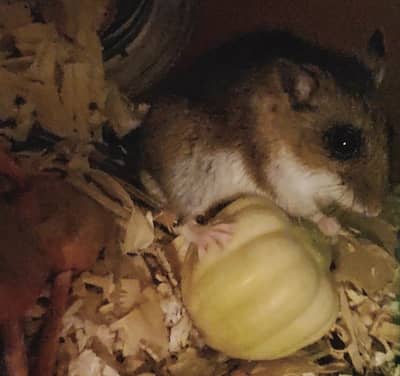
With the arrival of June and the summer all sorts of mammals seem to reveal themselves out in the woods and fields, including humans. However, the most abundant wild mammal in this area is seldom seen outdoors due to its small size and nocturnal nature. That animal is the deer mouse. You may find up to twenty- two per two acres of these adorable little neighbours. They don’t mind sharing their dens with their fellows or even other mice species. The only exception is a female with a fresh litter of pups (baby mice). But even she will let the father return after a few days to help clean and raise the young. He will even take them out on father-child foraging expeditions, another reason to think of deer mice in June near father’s day.
A deer mouse is most recognized by its two-tone colouration of brownish grey on top and white underneath. I like to think of it as having recently walked through a puddle of milk. The colours are where its name come from as it resembles a deer. Other distinguishing features include the big beady black eyes and big round ears. Even those in the profession of removing mice from homes can admit that the deer mouse is cute. The tail, which is also two- toned, is at least half the size of its body or longer depending on the subspecies. This tail can also be semi-prehensile, meaning it can be used to help grab branches and grass blades while the mouse balances.
Deer mice are herbivores but can also eat insects. They will forage through the fields collecting up seeds and storing them in their cheek pouches before depositing them into their caches (the equivalent of a mouse pantry). They play a big role in moving the energy from the plants up into the food chain. Several predators rely on the abundance of deer mice to keep them heathy, from fish to squirrels to even bears. And they make up a large part of the nocturnal owl species’ diet.
Now before you start welcoming the deer mouse into your house (where they often show up in the winter months) it should be noted that they can be transmitters of the Hantavirus, around 30 % are carriers. It is best to remove their access into your home and make sure you clean up any mouse dropping by wearing a mask and wetting the droppings first.
If you would like to catch a glimpse of the elusive, yet abundant neighbourhood deer mice then I would suggest doing a Seton Watch around dusk. This is where you find a comfortable spot to sit quietly and wait outside in a natural area. After several minutes the wildlife will begin to think of you as part of the scenery and slowly start to go about their business. You can often be rewarded for your patience by the sight of emerging deer mice and other small creatures heading out on their nightly forages from their nests. Deer mice are quite tolerant of human observers and will usually provide a good show.
Happy Seton Watching.

























